Physiological and Psychological Effects of Watching Videos of Different Durations Showing Urban Bamboo Forests with Varied Structures
Abstract
:1. Introduction
2. Materials and Methods
2.1. Urban Bamboo Forests Sites
2.2. Horizontal 360° Urban Bamboo Forest Videos
2.3. Participants
2.4. Experimental Sites
2.5. Experimental Design
2.6. Data Collection
2.7. Data Analysis
3. Results
3.1. Physiological Effects of Urban Bamboo Forest Videos of Different Durations on Humans
3.1.1. EEG
3.1.2. Blood Pressure
3.1.3. Skin Conductance
3.1.4. Pulse
3.2. Physiological and Psychological Effects of Urban Bamboo Forest Videos Showing Different Structures
3.2.1. Bamboo Species
3.2.2. Bamboo Height, DBH, Density, and Canopy Density
3.2.3. Tilt Ratio
3.2.4. Undergrowth Uniformity
4. Discussion
4.1. Human Physiological Indices in Response to Urban Bamboo Forest Videos of Different Durations
4.2. The Different Physiological and Psychological Effects of Videos of Urban Bamboo Forests with Various Structures
4.3. Limitations and Future Research
5. Conclusions
Author Contributions
Funding
Acknowledgments
Conflicts of Interest
References
- Mckenzie, K.; Murray, A.; Booth, T. Do urban environments increase the risk of anxiety, depression and psychosis? An epidemiological study. J. Affect. Disord. 2013, 150, 1019–1024. [Google Scholar] [CrossRef] [PubMed] [Green Version]
- Gong, P.; Liang, S.; Carlton, E.J.; Jiang, Q.; Wu, J.; Wang, L.; Remais, J.V. Urbanisation and health in China. Lancet 2012, 379, 843–852. [Google Scholar] [CrossRef]
- Tsunetsugu, Y.; Park, B.; Ishii, H.; Hirano, H. Physiological Effects of Shinrin-yoku (Taking in the Atmosphere of the Forest) in an Old-Growth Broadleaf Forest in Yamagata Prefecture, Japan. J. Physiol. Anthropol. 2007, 26, 135–142. [Google Scholar] [CrossRef] [PubMed] [Green Version]
- Tsunetsugu, Y.; Lee, J.; Park, B.; Tyrväinen, L.; Kagawa, T.; Miyazaki, Y. Physiological and psychological effects of viewing urban forest landscapes assessed by multiple measurements. Landsc. Urban Plan. 2013, 113, 90–93. [Google Scholar] [CrossRef]
- Shanahan, D.F.; Bush, R.; Gaston, K.J.; Lin, B.B.; Dean, J.; Barber, E.; Fuller, R.A. Health Benefits from Nature Experiences Depend on Dose. Sci. Rep. 2016, 6, 28551. [Google Scholar] [CrossRef] [PubMed] [Green Version]
- Morita, E.; Fukuda, S.; Nagano, J.; Hamajima, N.; Yamamoto, H.; Iwai, Y.; Shirakawa, T. Psychological effects of forest environments on healthy adults: Shinrin-yoku (forest-air bathing, walking) as a possible method of stress reduction. Public Health 2007, 121, 54–63. [Google Scholar] [CrossRef] [PubMed] [Green Version]
- Lee, J.; Park, B.J.; Tsunetsugu, Y.; Ohira, T.; Kagawa, T.; Miyazaki, Y. 7 Effect of forest bathing on physiological and psychological responses in young Japanese male subjects. Public Health 2011, 125, 93–100. [Google Scholar] [CrossRef]
- Lee, J.; Tsunetsugu, Y.; Takayama, N.; Park, B.J.; Li, Q.; Song, C.; Miyazaki, Y. Influence of forest therapy on cardiovascular relaxation in young adults. Evid. Based Complementary Altern. Med. 2014, 1–7. [Google Scholar] [CrossRef]
- Li, Q.; Morimoto, K.I.; Kobayashi, M.; Inagaki, H.; Katsumata, M.; Hirata, Y.; Products, F. Visiting a forest, but not a city, increases human natural killer activity and expression of anti-cancer proteins. Int. J. Immunopathol. Pharmacol. 2008, 21, 117–127. [Google Scholar] [CrossRef]
- Jia, B.; Yang, Z.; Mao, G.; Lyu, Y.; Wen, X.; Xu, W.H.; Wang, G. Letter to the Editor Health Effect of Forest Bathing Trip on Elderly Patients with Chronic Obstructive Pulmonary Disease *. Biomed. Environ. Sci. 2016, 29, 212–218. [Google Scholar] [CrossRef]
- Sonntag-öström, E.; Nordin, M.; Lundell, Y.; Dolling, A.; Wiklund, U.; Karlsson, M.; Slunga, L. Restorative effects of visits to urban and forest environments in patients with exhaustion disorder. Urban For. Urban Green. 2014, 13, 344–354. [Google Scholar] [CrossRef]
- Park, B.; Furuya, K.; Kasetani, T.; Takayama, N.; Kagawa, T. Relationship between psychological responses and physical environments in forest settings. Landsc. Urban Plan. 2011, 102, 24–32. [Google Scholar] [CrossRef]
- Berman, M.G.; Kross, E.; Krpan, K.M.; Askren, M.K.; Burson, A.; Deldin, P.J.; Jonides, J. Interacting with nature improves cognition and affect for individuals with depression. J. Affect. Disord. 2012, 140, 300–305. [Google Scholar] [CrossRef] [PubMed] [Green Version]
- Bielinis, E.; Takayama, N.; Boiko, S.; Omelan, A.; Bielinis, L. The effect of winter forest bathing on psychological relaxation of young Polish adults. Urban For. Urban Green. 2018, 29, 276–283. [Google Scholar] [CrossRef]
- Zhou, Y.; Zhang, H.; Guo, F.; Wang, Q. Bamboo Forest Certification in China: Status Quo and Trend of Development. World For. Res. 2019, 32, 78–82. [Google Scholar] [CrossRef]
- Reid, S.; Díaz, I.A.; Armesto, J.J.; Mary, F. Importance of Native Bamboo for Understory Birds in Chilean Temperate Forests. Auk 2004, 121, 515–525. [Google Scholar] [CrossRef]
- Zhang, X.; Zhong, B.; Shafi, M.; Guo, J.; Liu, C.; Guo, H.; Liu, D. Effect of EDTA and citric acid on absorption of heavy metals and growth of Moso bamboo. Environ. Sci. Pollut. Res. 2018, 25, 18846–18852. [Google Scholar] [CrossRef]
- Cai, C.; Fan, S.; Liu, G.; Wang, S.; Feng, Y. Research and Development Advance of Compound Management of Bamboo Forests. World Bamboo Rattan 2018, 16, 47–52. [Google Scholar] [CrossRef]
- Zhang, X.; Wen, T.; Li, D.; Li, J.W.; Huo, D.; Jiang, X.; Yuan, K.L. Bamboo industry ecosystem structure and evolution: An example of Chishui City, Guizhou Province, China. Acta Ecol. Sin. 2016, 36, 7310–7322. [Google Scholar] [CrossRef]
- Park, B.; Tsunetsugu, Y.; Morikawa, T.; Kagawa, T.; Lee, J.; Ikei, H.; Miyazaki, Y. Physiological and Psychological Effects of Walking in Stay-in Forest Therapy. Nippon Eiseigaku Zasshi (Jpn. J. Hyg.) 2014, 69, 98–103. [Google Scholar] [CrossRef] [Green Version]
- Han, J.W.; Choi, H.; Jeon, Y.H.; Yoon, C.H.; Woo, J.M.; Kim, W. The effects of forest therapy on coping with chronic widespread pain: Physiological and psychological differences between participants in a forest therapy program and a control group. Int. J. Environ. Res. Public Health 2016, 13, 255. [Google Scholar] [CrossRef] [PubMed] [Green Version]
- Lee, J.; Park, B.J.; Tsunetsugu, Y.; Kagawa, T.; Miyazaki, Y. Restorative effects of viewing real forest landscapes, based on a comparison with urban landscapes. Scand. J. For. Res. 2009, 24, 227–234. [Google Scholar] [CrossRef]
- Lin, W.; Chen, Q.; Jiang, M.; Zhang, X.; Liu, Z.; Tao, J.; Zeng, Q. The effect of green space behaviour and per capita area in small urban green spaces on psychophysiological responses. Landsc. Urban Plan. 2019, 192, 103637. [Google Scholar] [CrossRef]
- Lyu, B.; Zeng, C.; Deng, S.; Liu, S.; Jiang, M.; Li, N.; Chen, Q. Bamboo forest therapy contributes to the regulation of psychological responses. J. For. Res. 2019, 24, 61–70. [Google Scholar] [CrossRef]
- Berto, R. Exposure to restorative environments helps restore attentional capacity. J. Environ. Psychol. 2005, 25, 249–259. [Google Scholar] [CrossRef]
- Pals, R.; Steg, L.; Dontje, J.; Siero, F.W.; van der Zee, K.I. Physical features, coherence and positive outcomes of person-environment interactions: A virtual reality study. J. Environ. Psychol. 2014, 40, 108–116. [Google Scholar] [CrossRef]
- Arriaza, M.; Cañas-Ortega, J.F.; Cañas-Madueño, J.A.; Ruiz-Aviles, P. Assessing the visual quality of rural landscapes. Landsc. Urban Plan. 2004, 69, 115–125. [Google Scholar] [CrossRef]
- Oh, B.; Lee, K.J.; Zaslawski, C.; Yeung, A.; Rosenthal, D.; Larkey, L.; Back, M. Health and well-being benefits of spending time in forests: Systematic review. Environ. Health Prev. Med. 2017, 22, 1–12. [Google Scholar] [CrossRef]
- Lee, I.; Choi, H.; Bang, K.S.; Kim, S.; Song, M.K.; Lee, B. Effects of forest therapy on depressive symptoms among adults: A systematic review. Int. J. Environ. Res. Public Health 2017, 14, 321. [Google Scholar] [CrossRef]
- Ernest, W. The Use of Videotape as an Environmental Presentation Medium in Environment Preference Research; The University of Arizona: Tucson, AZ, USA, 1985. [Google Scholar]
- Jeon, J.Y.; Yeon, P.S.; Shin, W.S. The influence of indirect nature experience on human system. For. Sci. Technol. 2018, 14, 29–32. [Google Scholar] [CrossRef] [Green Version]
- Jiang, M.; Hassan, A.; Chen, Q.; Liu, Y. Effects of different landscape visual stimuli on psychophysiological responses in Chinese students. Indoor Built Environ. 2019, 0, 1–11. [Google Scholar] [CrossRef]
- Hassan, A.; Tao, J.; Li, G.; Jiang, M.; Aii, L.; Zhihui, J.; Qibing, C. Effects of Walking in Bamboo Forest and City Environments on Brainwave Activity in Young Adults. Evid. Based Complementary Altern. Med. 2018, 9653857. [Google Scholar] [CrossRef] [PubMed]
- Hoshiba, M.A.; Gonçalves, F.D.; Urbinati, E.C. Physiological stress responses of matrinxã (Brycon amazonicus) after chasing. Acta Amaz. 2009, 39, 445–452. [Google Scholar] [CrossRef] [Green Version]
- Sung, J.; Woo, J.; Kim, W.; Lim, S.; Chung, E. The Effect of Cognitive Behavior Therapy-Based “Forest Therapy” Program on Blood Pressure, Salivary Cortisol Level, and Quality of Life in Elderly Hypertensive Patients. J. Physiol. Anthropol. 2012, 34, 1–7. [Google Scholar] [CrossRef] [PubMed]
- Lee, M.; Lee, J.; Park, B.; Miyazaki, Y. Interaction with indoor plants may reduce psychological and physiological stress by suppressing autonomic nervous system activity in young adults: A randomized crossover study. J. Physiol. Anthropol. 2015, 34, 1–6. [Google Scholar] [CrossRef] [PubMed] [Green Version]
- Ochiai, H.; Ikei, H.; Song, C.; Kobayashi, M.; Takamatsu, A.; Miura, T.; Miyazaki, Y. Physiological and psychological effects of forest therapy on middle-aged males with high-normal blood pressure. Int. J. Environ. Res. Public Health 2015, 12, 2532–2542. [Google Scholar] [CrossRef] [Green Version]
- Hot, P.; Naveteur, J.; Leconte, P.; Sequeira, H. Diurnal variations of tonic electrodermal activity. Int. J. Psychophysiol. 1999, 33, 223–230. [Google Scholar] [CrossRef]
- Park, S.H.; Lee, P.J. Effects of floor impact noise on psychophysiological responses. Build. Environ. 2017, 116, 173–181. [Google Scholar] [CrossRef] [Green Version]
- Morfeld, M.; Petersen, C.; Krüger-Bödeker, A.; von Mackensen, S.; Bullinger, M. The assessment of mood at workplace—Psychometric analyses of the revised Profile of Mood States (POMS) questionnaire. Psycho Soc. Med. 2007, 4, 1–9. [Google Scholar]
- Zhu, B. Brief introduction of poms scale and its model for China. J. Tianjin Inst. Phys. Educ. 1995, 10, 35–37. [Google Scholar] [CrossRef]
- Mo, L.; He, Y.; Liu, Y.; Zhao, J.; Tang, S.-J.; Li, X.-Y.; Dai, G. Canopy closure estimates with GreenOrbs: Sustainable sensing in the forest. ACM Conf. Embed. Netw. Sens. Syst. 2009, 99–112. [Google Scholar] [CrossRef] [Green Version]
- Kennedy, J.M. A Sense of Order—A Study in the Psychology of Decorative Art. J. Aesthet. Art Crit. 2016, 38, 453–457. [Google Scholar] [CrossRef]
- Komori, T.; Mitsui, M.; Togashi, K.; Matsui, J.; Kato, T.; Uei, D.; Kinoshita, F. Relaxation Effect of a 2-Hour Walk in Kumano-Kodo Forest. J. Neurol. Neurosci. 2017, 8, 174. [Google Scholar] [CrossRef]
- Song, C.; Ikei, H.; Miyazaki, Y. Physiological Effects of Visual Stimulation with Forest Imagery. Int. J. Environ. Res. Public Health 2018, 15, 213. [Google Scholar] [CrossRef] [PubMed] [Green Version]
- Song, C.; Ikei, H.; Igarashi, M.; Miwa, M.; Takagaki, M.; Miyazaki, Y. Physiological and psychological responses of young males during spring-time walks in urban parks. J. Physiol. Anthropol. 2014, 33, 8. [Google Scholar] [CrossRef] [PubMed] [Green Version]
- Lee, J.; Lee, D. Cardiac and pulmonary benefits of forest walking versus city walking in elderly women: A randomised, controlled, open-label trial. Eur. J. Integr. Med. 2014, 6, 5–11. [Google Scholar] [CrossRef]
- Ochiai, H.; Ikei, H.; Song, C.; Kobayashi, M.; Miura, T.; Kagawa, T.; Miyazaki, Y. Physiological and psychological effects of a forest therapy program on middle-aged females. Int. J. Environ. Res. Public Health 2015, 12, 15222–15232. [Google Scholar] [CrossRef] [Green Version]
- Lee, J. Experimental study on the health benefits of garden landscape. Int. J. Environ. Res. Public Health 2017, 14, 829. [Google Scholar] [CrossRef] [Green Version]
- Park, B.; Tsunetsugu, Y.; Kasetani, T.; Morikawa, T.; Kagawa, T.; Miyazaki, Y. Physiological effects of forest recreation in a young conifer forest in Hinokage Town, Japan. Silva Fenn. 2009, 43, 291–301. [Google Scholar] [CrossRef] [Green Version]
- Song, C.; Lee, J.; Ikei, H.; Kagawa, T.; Miyazaki, Y.; Ikei, H.; Park, B. Physiological and Psychological Effects of Walking Around and Viewing a Lake in a Forest Environment. J. Korean For. Soc. 2015, 104, 140–149. [Google Scholar] [CrossRef]
- Song, C.; Joung, D.; Ikei, H.; Igarashi, M.; Aga, M.; Park, B.; Miyazaki, Y. Physiological and psychological effects of walking on young males in urban parks in winter. J. Physiol. Anthropol. 2013, 32, 18. [Google Scholar] [CrossRef] [PubMed] [Green Version]
- Song, C.; Ikei, H.; Igarashi, M.; Takagaki, M.; Miyazaki, Y. Physiological and Psychological Effects of a Walk in Urban Parks in Fall. Int. J. Environ. Res. Public Health 2015, 12, 14216–14228. [Google Scholar] [CrossRef] [PubMed]
- Ohtsuka, Y.; Yabunaka, N.; Takayama, S. Shinrin-yoku (forest-air bathing and walking) effectively decreases blood glucose levels in diabetic patients. Int. J. Biometeorol. 1998, 41, 125–127. [Google Scholar] [CrossRef] [PubMed]
- Sonntag-Öström, E.; Nordin, M.; Dolling, A.; Lundell, Y.; Nilsson, L.; Slunga Järvholm, L. Can rehabilitation in boreal forests help recovery from exhaustion disorder? The randomised clinical trial ForRest. Scand. J. For. Res. 2015, 30, 732–748. [Google Scholar] [CrossRef]
- Gerstenberg, T.; Hofmann, M. Perception and preference of trees: A psychological contribution to tree species selection in urban areas. Urban For. Urban Green. 2016, 15, 103–111. [Google Scholar] [CrossRef]
- Guan, H.; Wei, H.; He, X.; Ren, Z.; An, B. The tree-species-specific effect of forest bathing on perceived anxiety alleviation of young-adults in urban forests. Ann. For. Res. 2017, 60, 327–341. [Google Scholar] [CrossRef]
- Lee, K.J.; Hur, J.; Yang, K.; Lee, M.; Lee, S. Acute Biophysical Responses and Psychological Effects of Different Types of Forests in Patients With Metabolic Syndrome. Environ. Behav. 2018, 50, 298–323. [Google Scholar] [CrossRef]
- Oron-Gilad, T.; Ronen, A. Road characteristics and driver fatigue: A simulator study. Traffic Injury Prev. 2007, 8, 281–289. [Google Scholar] [CrossRef]

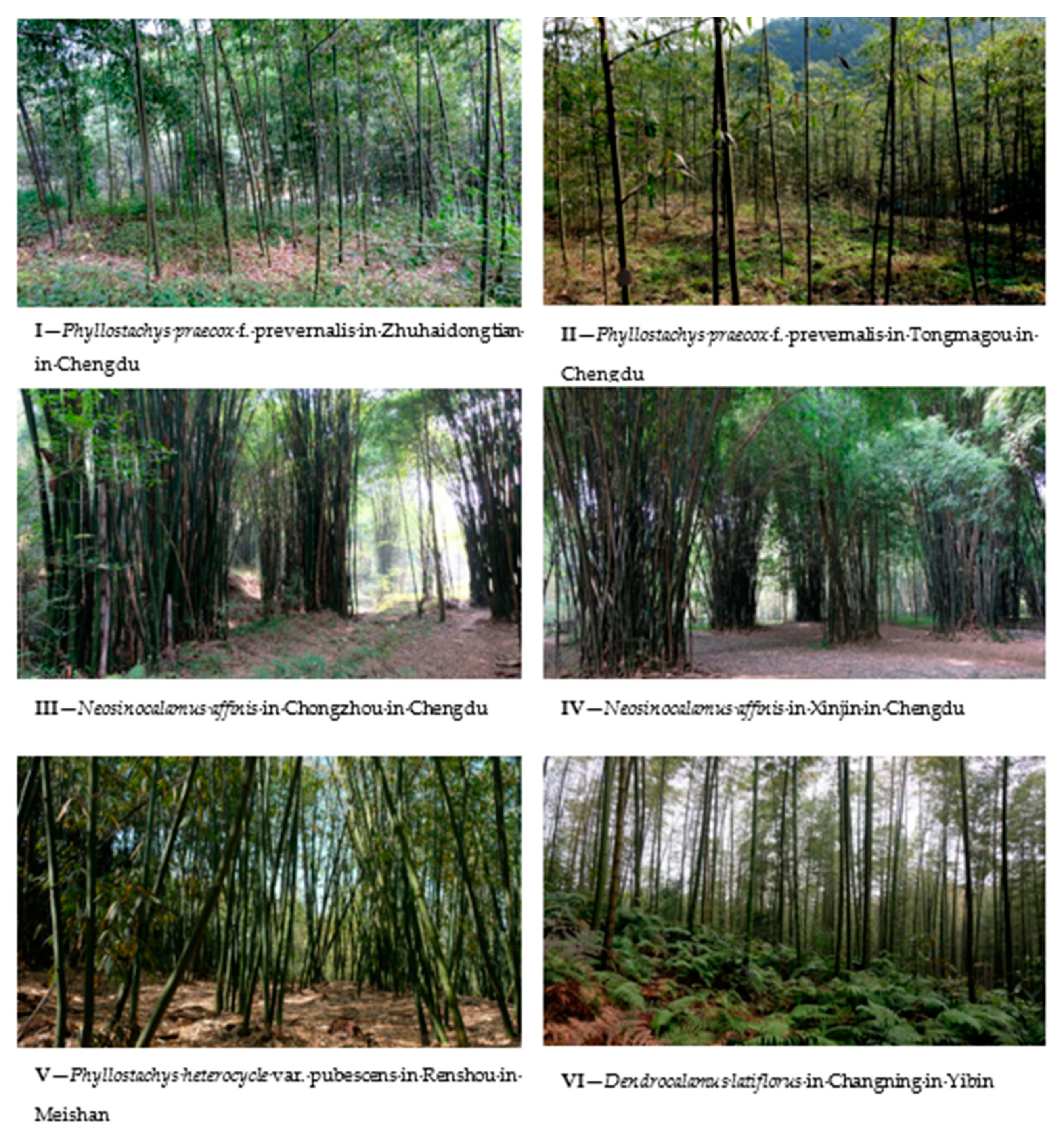
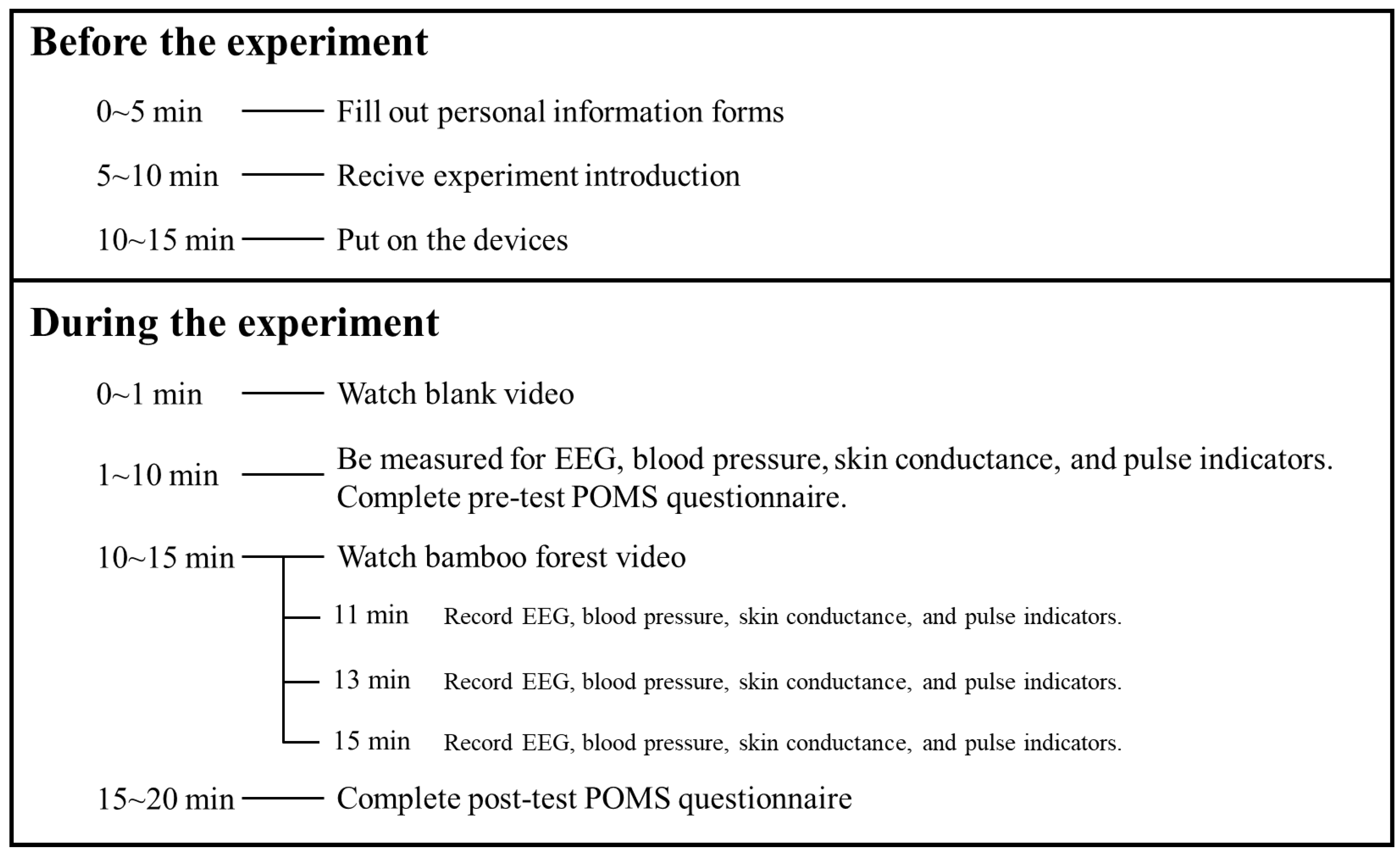

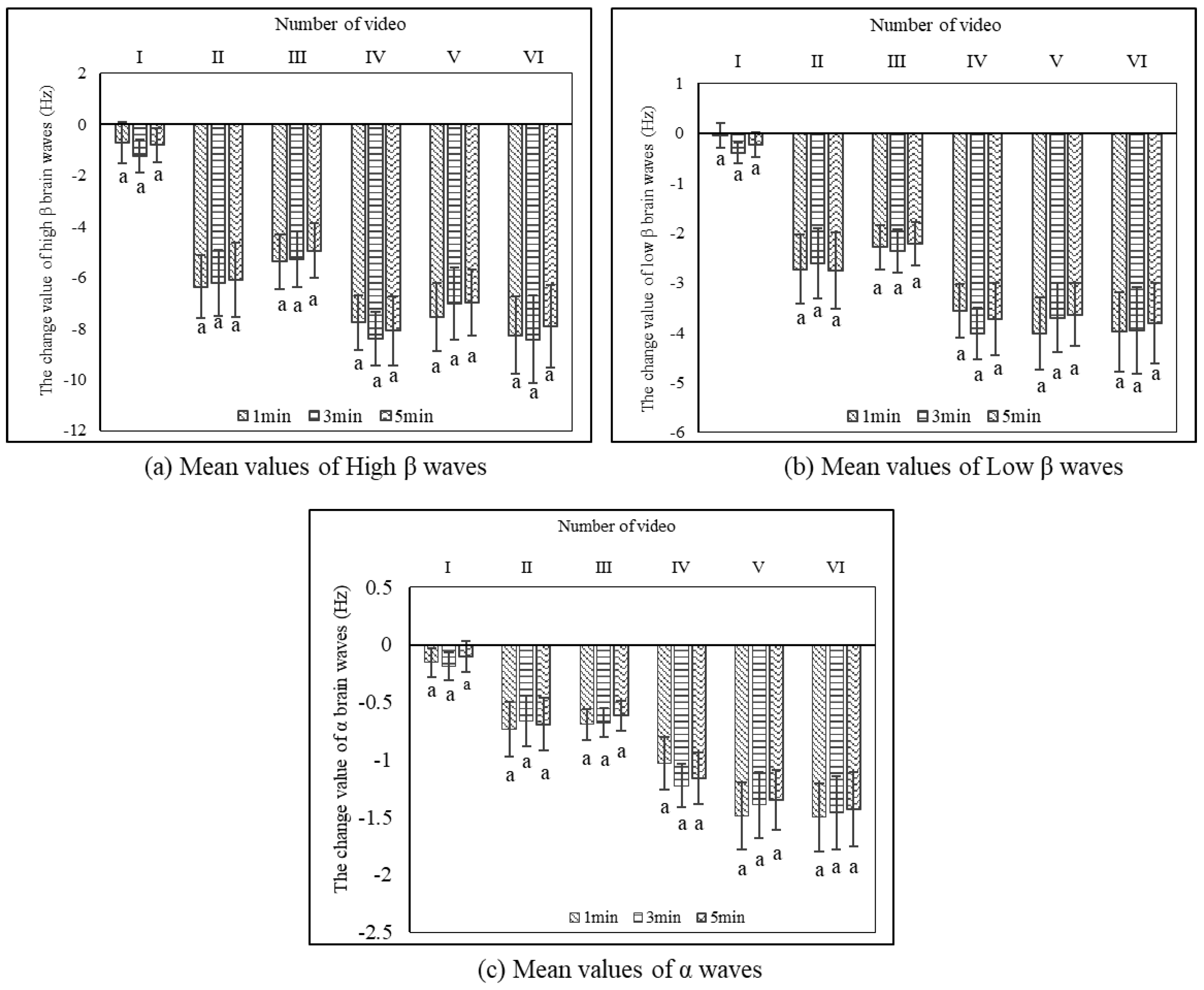
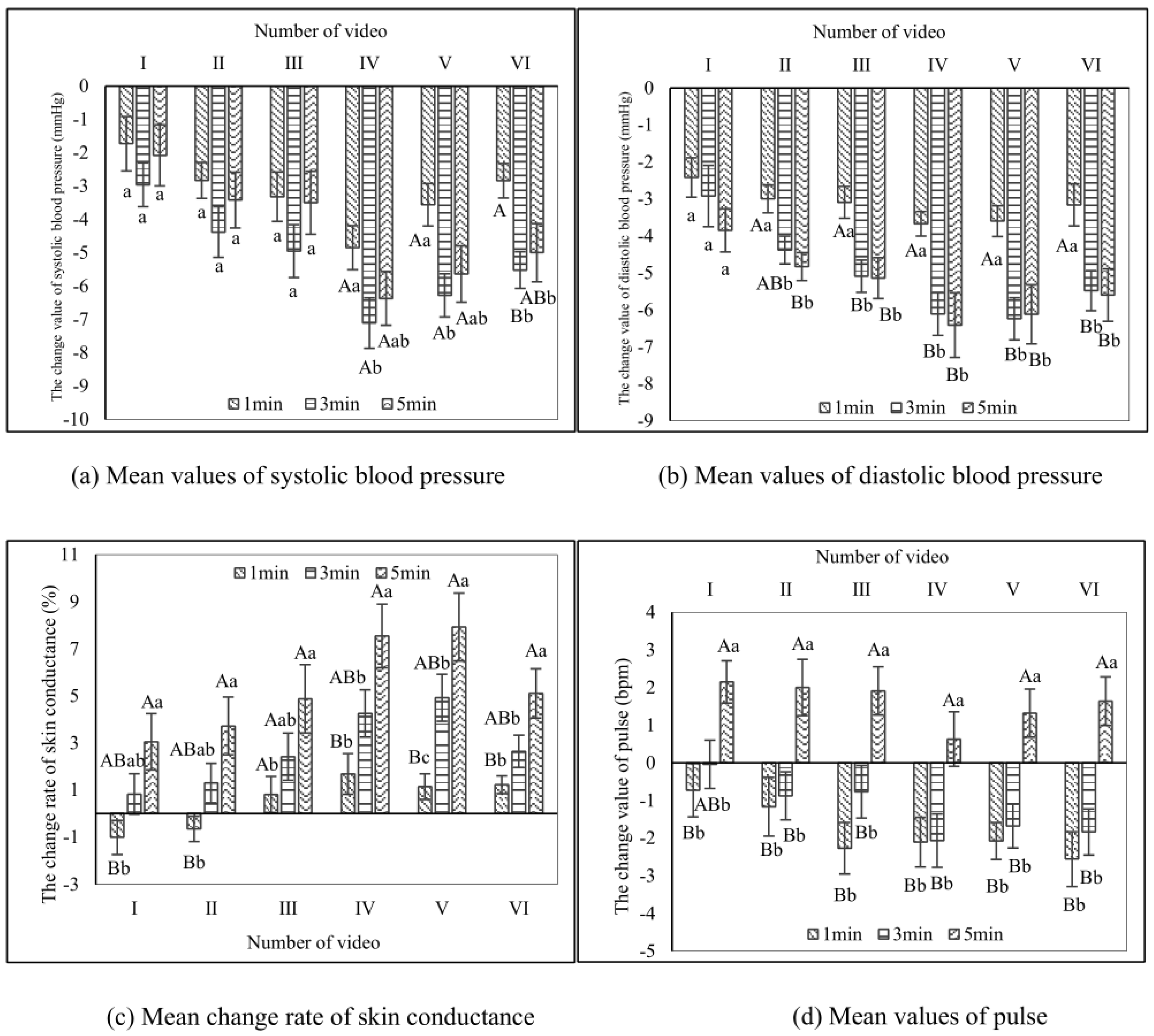
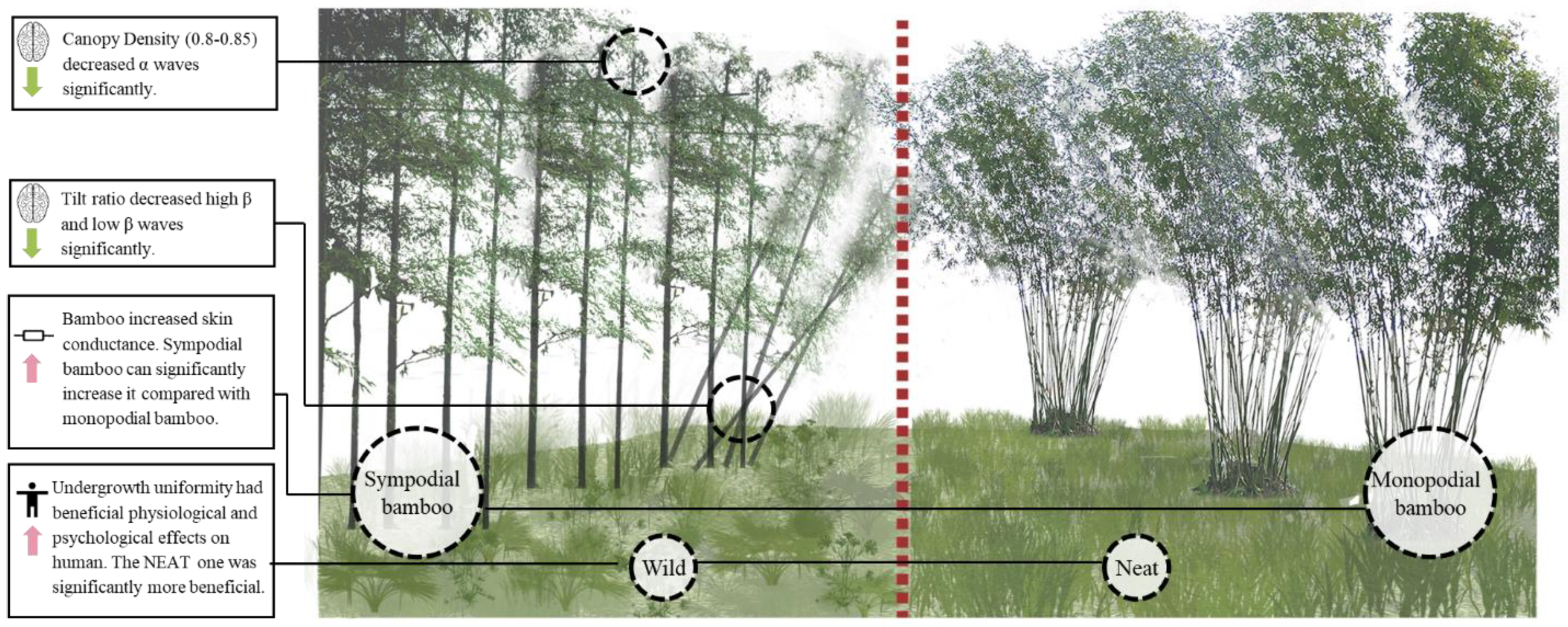
| Characteristics | Name | |||||
|---|---|---|---|---|---|---|
| I—Phyllostachys praecox f. Prevernalis in Zhuhaidongtian in Chengdu | II—Phyllostachys praecox f. Prevernalis in Tongmagou in Chengdu | III—Neosinocalamus affinis in Chongzhou in Chengdu | IV—Neosinocalamus affinis in Xinjin in Chengdu | V—Phyllostachys heterocycle var. pubescens in Renshou in Meishan | VI—Dendrocalamus latiflorus in Changning in Yibin | |
| Bamboo Species | Monopodial bamboo | Monopodial bamboo | Sympodial bamboo | Sympodial bamboo | Sympodial bamboo | Monopodial bamboo |
| Bamboo Height (m) | 9.03 ± 0.47 | 8.63 ± 0.64 | 15.33 ± 0.75 | 14.97 ± 0.80 | 20.43 ± 0.85 | 18.67 ± 0.57 |
| DBH (cm) | 5.13 ± 0.31 | 5.20 ± 0.50 | 5.07 ± 0.47 | 5.17 ± 0.40 | 14.63 ± 1.07 | 12.33 ± 0.47 |
| Density (strain/ha) | 19,300 ± 1527 | 17,666 ± 577 | 22,000 ± 1732 | 21,300 ± 2000 | 5400 ± 360 | 3600 ± 360 |
| Canopy Density | 0.69 ± 0.02 | 0.71 ± 0.02 | 0.77 ± 0.04 | 0.78 ± 0.04 | 0.83 ± 0.08 | 0.85 ± 0.03 |
| Tilt Ratio (%) | 5.45 ± 1.99 | 0.35 ± 0.61 | 6.82 ± 0.62 | 1.27 ± 1.19 | 0.97 ± 0.87 | 0.62 ± 1.07 |
| Undergrowth Uniformity | Wild | Normal | Normal | Neat | Neat | Normal |
| Physiological and Psychological Indicators | Video I | Video II | Video III | Video IV | Video V | Video VI |
|---|---|---|---|---|---|---|
| Skin Conductance (%) | 3.05 ± 1.196 Ac | 3.72 ± 1.23 Abc | 4.88 ± 1.45 Aabc | 7.54 ± 1.35 Aab | 7.92 ± 1.44 Aa | 5.10 ± 1.04 Aabc |
| α Wave (Hz) | −0.15 ± 0.13 Aa | −0.73 ± 0.24 ABab | −0.69 ± 0.13 ABab | −1.03 ± 0.23 ABbc | −1.49 ± 0.29 Bc | −22,121.5 ± 0.29 Bc |
| High β Wave (Hz) | −0.73 ± 0.82 Aa | −6.36 ± 1.25 Bb | −5.38 ± 1.07 Bb | −7.76 ± 1.08 Bb | −7.55 ± 1.34 Bb | −8.27 ± 1.52 Bb |
| Low β Wave (Hz) | −0.04 ± 0.25 Aa | −2.73 ± 0.70 Bb | −2.286 ± 0.44 Bb | −3.56 ± 0.55 Bb | −4.01 ± 0.73 Bb | −3.98 ± 0.79 Bb |
| Systolic Blood Pressure (mmHg) | −2.96 ± 0.66 Aa | −4.38 ± 0.76 ABab | −4.95 ± 0.80 ABab | −7.11 ± 0.76 Bc | −6.28 ± 0.65 Bbc | −5.52 ± 0.55 ABbc |
| Diastolic Blood Pressure (mmHg) | −2.92 ± 0.83 Aa | −4.38 ± 0.38 ABab | −5.09 ± 0.44 ABbc | −6.11 ± 0.58 Bbc | −6.24 ± 0.57 Bc | −5.48 ± 0.54 Bbc |
| Pulse (bmp) | −0.04 ± 0.64 a | −0.88 ± 0.64 a | −0.77 ± 0.70 a | −2.07 ± 0.71 a | −1.68 ± 0.58 a | −1.84 ± 0.61 a |
| Negative POMS Scores | −3.19 ± 0.49 Aa | −4.38 ± 0.59 Aab | −4.86 ± 1.30 Aab | −5.96 ± 0.93 Ab | −6.12 ± 0.68 Ab | −5.6 ± 0.83 Aab |
| Positive POMS Scores | −0.96 ± 0.671 a | 0.17 ± 0.726 a | 0.27 ± 0.519 a | 0.59 ± 0.463 a | 0.6 ± 0.440 a | 0.48 ± 0.421 a |
| Physiological and Psychological Indicators | Bamboo Species | Density | Bamboo Height | DBH | Canopy Density | Tilt Ratio | Undergrowth Uniformity |
|---|---|---|---|---|---|---|---|
| Skin Conductance (%) | −0.780 | −0.286 | 0.769 | 0.481 | 0.697 | −0.429 | 0.944 ** |
| α Waves (Hz) | 0.289 | 0.783 | −0.870 * | −0.837 * | −0.938 ** | 0.696 | −0.732 |
| High β Waves (Hz) | 0.349 | 0.486 | −0.675 | −0.523 | −0.783 | 0.719 | −0.817 * |
| Low β Waves (Hz) | 0.378 | 0.578 | −0.756 | −0.634 | −0.840 * | 0.730 | −0.842 * |
| Systolic Blood Pressure (Mmhg) | 0.685 | 0.246 | −0.719 | −0.384 | −0.730 | 0.527 | −0.951 ** |
| Diastolic Blood Pressure (Mmhg) | 0.685 | 0.383 | −0.828* | −0.527 | −0.831 * | 0.507 | −0.940 ** |
| Pulse (Bmp) | 0.413 | 0.476 | −0.730 | −0.540 | −0.813 * | 0.712 | −0.852 * |
| Negative POMS Scores | 0.617 | 0.466 | −0.851 * | −0.595 | −0.868 * | 0.568 | −0.923 ** |
| Positive POMS Scores | −0.548 | −0.370 | 0.719 | 0.462 | 0.775 | −0.572 | 0.882 * |
© 2020 by the authors. Licensee MDPI, Basel, Switzerland. This article is an open access article distributed under the terms and conditions of the Creative Commons Attribution (CC BY) license (http://creativecommons.org/licenses/by/4.0/).
Share and Cite
Wang, Y.; Jiang, M.; Huang, Y.; Sheng, Z.; Huang, X.; Lin, W.; Chen, Q.; Li, X.; Luo, Z.; Lv, B. Physiological and Psychological Effects of Watching Videos of Different Durations Showing Urban Bamboo Forests with Varied Structures. Int. J. Environ. Res. Public Health 2020, 17, 3434. https://0-doi-org.brum.beds.ac.uk/10.3390/ijerph17103434
Wang Y, Jiang M, Huang Y, Sheng Z, Huang X, Lin W, Chen Q, Li X, Luo Z, Lv B. Physiological and Psychological Effects of Watching Videos of Different Durations Showing Urban Bamboo Forests with Varied Structures. International Journal of Environmental Research and Public Health. 2020; 17(10):3434. https://0-doi-org.brum.beds.ac.uk/10.3390/ijerph17103434
Chicago/Turabian StyleWang, Yuqian, Mingyan Jiang, Yinshu Huang, Zhiyi Sheng, Xiao Huang, Wei Lin, Qibing Chen, Xi Li, Zhenghua Luo, and Bingyang Lv. 2020. "Physiological and Psychological Effects of Watching Videos of Different Durations Showing Urban Bamboo Forests with Varied Structures" International Journal of Environmental Research and Public Health 17, no. 10: 3434. https://0-doi-org.brum.beds.ac.uk/10.3390/ijerph17103434





